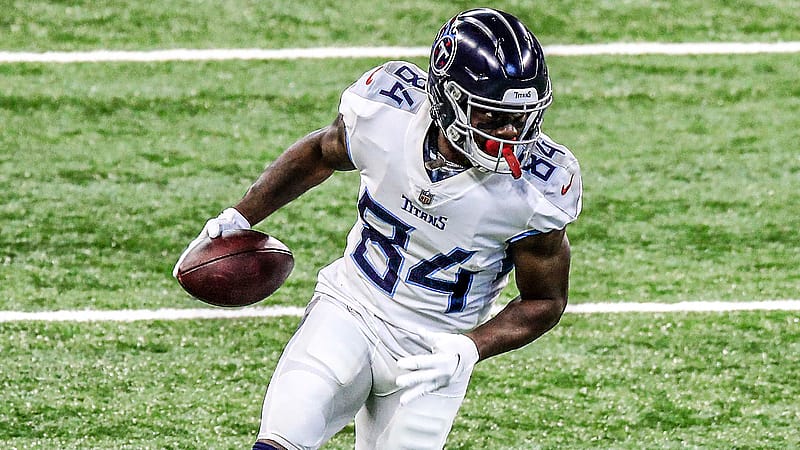Jets X-Factor digs into the dynasty fantasy football outlook for New York Jets wide receiver Corey Davis. What’s his long-term value?
The New York Jets overhauled their wide receiver room by spending big on former Tennessee Titans’ first-round pick Corey Davis this offseason. The former fifth-overall pick never fully met the high expectations in Tennessee—something Joe Douglas is banking on in terms of value.
It’s why the 2020 season is an interesting one in the kid’s career.
Davis put forth a career year in 2020, hauling in 65 receptions for 984 yards and five touchdowns—all career highs (though he also had 65 receptions in 2018). He also enjoyed his highest fantasy football seasonal ranking, finishing as the WR30. Finishing 32nd among wide receivers in FPPG (fantasy points per game), Davis solidified himself as a low-end WR2/high-end WR3.
Davis will have another opportunity to lead a wide receiver group with the Jets, and the new scheme being implemented should work in his favor.
Strengths
Davis is one of the best wide receivers when working intermediate routes (10-to-19 yards downfield). Last season he had the seventh-most targets on such routes (40), with the eighth-highest receiving grade under that criterion (98.7), per PFF.
‘Big playmaker’ may be a bit too outlandish of a description of Davis, but he has shown to be an incredibly reliable player between the 20s and had the 10th-highest yards-per-reception rate among all wide receivers with at least 70 targets at 15.1.
On top of that, Davis has shown incredibly sure hands throughout his career. His drop rate isn’t shockingly good (5.5% for career, slightly better than average), but his ability to pull down contested catches has been on an elite level. With a contested-catch percentage of 64.7, he finished eighth in 2020, showing the type of hands you look for in a WR1.
Weaknesses
To be frank, Davis wouldn’t be a Jets weapon right now if he didn’t have some weaknesses to his game as well. It’s rare to find fifth-overall selections who aren’t retained by their team in the fifth year (though the Jets know all too well about that as well) without referring to them as busts. While Davis wasn’t quite at a “bust level” for the Titans, there are some areas of weakness.
One reason for Davis’ great contested catch numbers is due to the fact that he’s actually pretty bad at gaining separation in his routes—at least when the numbers are analyzed.
Davis is tied for the 10th lowest separation rate with his then-teammate A.J. Brown at 2.4, barely above current Jets WR Denzel Mims who placed fifth with a 2.1 mark. While that isn’t a concern in and of itself, it does become murky considering Davis was given the ninth-largest cushion in the NFL.
While I do believe that someone with Davis’ size and speed should be exponentially better at getting yards after the catch (he ranked 54th out of 112 WRs with 4.4 YAC per reception), it isn’t quite as glaring of a weakness as his durability might be.
Davis plays through injuries, and that can cause him some trouble when looking at maximum value. He’s only played a full season once and being too tough for his own good could have come at a cost for his performance.
Fantasy Football Outlook
With the New York Jets, Corey Davis will presumably be the WR1 for rookie quarterback Zach Wilson. He’ll have plenty of competition for targets with Denzel Mims, rookie Elijah Moore and Jamison Crowder, among others.
Despite becoming the guy in New York, I believe Davis’ numbers won’t change much now that he’s in green and white. Davis has been a player that consistently puts up WR2/3 numbers even when given the WR1 role, and I don’t expect that to change much going forward.
In my current fantasy football dynasty rankings, I have him as the WR31 as the highest-ranked Jets receiver. I think Davis will continue his production from previous years as the Jets morph their offense into a Shanahan-style unit, similar to the San Francisco 49ers.
With so many mouths to feed and a stable of running backs employed, Davis may not become an elite fantasy football option. But he can definitely be a solid WR2-3 throughout his tenure in New York.









